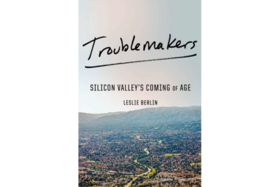Early Silicon Valley

By Jackson Holahan
Today’s Silicon Valley is known as much for its innovation as for the controversy that many of its most powerful companies elicit. Google and Facebook have transformed the way people connect to information and one another, and yet many consumers are wary of companies that gather increasingly granular data on their preferences and behaviors. Twitter’s executives were recently called to Washington to explain how their platform may have been used by foreign powers to influence the 2016 presidential election. Whatever happened to the days of yore when technology did nothing but improve our lives?
In "Troublemakers: Silicon Valley’s Coming of Age," Leslie Berlin, the project historian for the Silicon Valley Archives at Stanford University, transports us to a Silicon Valley before the arrival of Internet behemoths the likes of Netflix and Salesforce, when giants such as Fairchild Semiconductor and Intel ruled the day. She chronicles the heady days in the San Francisco Peninsula during the 1960s and 1970s when entirely new industries as well as new companies were being spawned. In roughly a decade, this 10-mile sliver of land gave birth to personal computing, recombinant DNA gene therapy, venture capital investing, and university technology licensing.
Berlin follows six characters whose stories illustrate the meteoric transformation of Silicon Valley’s founding generation, which gave rise to some of the world’s largest and most powerful companies. The overarching theme is that current technology is a direct product of the innovations, people, and industries that arose in the latter half of last century. As such, nearly every person Berlin profiles traces his or her roots to the semiconductor industry, Hewlett-Packard, University of California, Berkeley, or Stanford University.
One of the most colorful characters is Bob Taylor, a visionary leader at Xerox PARC who assembled a legendary team of engineers that developed the mouse-based graphical interface, the laser printer, and various important iterations of personal, distributed computing. PARC’s alumni include the founders of Adobe, various senior Apple engineering leaders, and three Turing Award winners, often considered the Nobel Prize of computer science.
Berlin romps through the ups and downs of Atari and Apple, following their mercurial and idiosyncratic executives through struggles, riches, failures, and successes alike. In an industry that continues to be male-dominated, the remarkable stories of Fawn Alvarez and Sandra Kurtzig are a welcome reminder of the outsized impact that women had throughout Silicon Valley’s history, both on the semiconductor manufacturing lines and within the executive suite.
There is much to learn from Berlin’s account, particularly that Silicon Valley has long provided the backdrop where technology, elite education, institutional capital, and entrepreneurship collide with incredible force. The results have produced some of the most powerful corporations and widely-used products and services the world has ever seen. Despite the certain benefits of powerful technology such as recombinant DNA, Berlin rightfully illustrates the nationwide alarm that resulted from the advent of a process that gave people editing power over human life. In this, as in many other cases, it is evident that the intent of a technology’s application is often more important than the technology itself.
Berlin devotes little more than a page to some of the less glamorous elements of modern day Silicon Valley: increasing income inequality, the perception of outsized political clout by large technology corporations, and unease among users who open up more and more of their lives to companies who are ultimately held to account by their shareholders.
But Berlin is a historian, not an editorialist, and her charge is to deliver the narrative, a task that she does with great style and storytelling skill. She relies on a trove of unpublished primary sources, including interviews, that few would be able to synthesize so deftly. It is not too difficult to envision a sequel of sorts, where Berlin captures the influence of today’s leading minds on the next generation of innovators, tools and products. In the meantime, we will have to watch the story unfold ourselves.